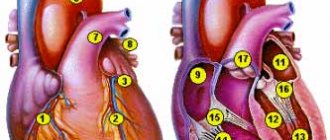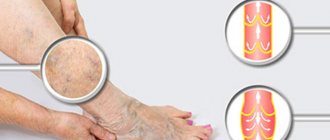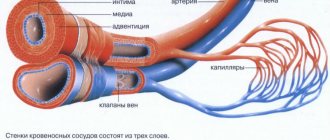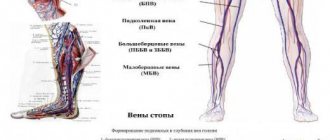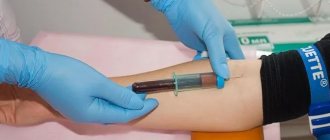In anatomy, the vein of Galen is considered the main venous trunk that drains venous blood from the brain. In fact, its branches intertwine all the internal structures of the brain, starting from the basal ganglia and lateral ventricles, and ending with the visual thalamus and the transparent septum. In its architecture, this vessel looks like a venous trunk running along the groove between the hemispheres, from which dense networks of thinner veins diverge in both directions. Its role is very large, and pathologies significantly affect the well-being and activity of the central nervous system, and can threaten the patient’s life.
They will live: how children with vein of Galen malformation are saved at St. Petersburg State Pediatric Medical University
Arteriovenous malformation of the vein of Galen is a very rare and very dangerous diagnosis. In severe cases of this pathology, newborns may die in the first days after birth. Survivors are at risk of cerebral hemorrhage.
Today, thanks to the capabilities of endovascular surgery, such patients have a chance for a long healthy life. The Pediatric University is one of the few places where children undergo complex operations on the blood vessels of the brain.
The vein of Galen is one of the largest vessels that collects blood from the deep parts of the cerebral hemispheres. This term means little to a person far from medicine. Margarita Vatutina heard it for the first time in her life during a routine ultrasound at the 30th week of pregnancy. And then she learned that for her unborn third daughter this was actually a death sentence.
“The doctors at the antenatal clinic didn’t give me a chance. They openly said that this was a rare diagnosis, that there was very little chance of survival,” Margarita recalls.
The woman lives in Tver; there are simply no medical centers there where they could provide assistance to her child. They began to issue a quota for treatment for the baby at the Perinatal Center of the Pediatric University - so that immediately after birth she would fall into the hands of surgeons.
But things didn't go according to plan. The expectant mother was unable to come to St. Petersburg State Pediatric Medical University in advance - at the 34th week her water broke. Out of despair, Margarita and her husband decided to take a desperate step: they got into a car and flew to the Northern capital in four and a half hours. Two hours later, Angelina was born.
The newborn did not scream or breathe on her own; she was immediately placed in the intensive care unit. The next day, the baby was operated on by the head of the neurosurgical service of St. Petersburg State Pediatric Medical University, the chief freelance pediatric neurosurgeon of St. Petersburg, Alexey Ivanov .
Firstly, not an aneurysm, secondly, not a malformation, thirdly, not the vein of Galen
– In medicine, there are also not very successful names. Therefore, if we are talking about venous-arterial malformation of the vein of Galen or aneurysm of the vein of Galen, then it should be said that, firstly, this is not an aneurysm, and secondly, as a rule, it is not a malformation. This is a collective name for a variety of pathologies,” explains Alexey Ivanov.
In addition, when it comes to the youngest patients, the cause of all the troubles is not even the vein of Galen - it forms later - but its “predecessor”.
One way or another, this “collective image” hides very threatening conditions in which the flow of arterial blood enters directly into the veins, bypassing the capillary bed of the brain matter.
The venous system, naturally, is not designed for blood pressure, so the vein of Galen begins to increase in size. Hence the term aneurysm, although it is more likely to be varicose veins.
– When we talk about children under six months old, then, as a rule, we are talking about two main dangers. This is, first of all, a gap in education itself. Colossal energy rushes into the venous system. And at some point this can lead to cerebral hemorrhage, says the head of the neurosurgical service.
In addition, the swollen vein of Galen can block the outflow of cerebrospinal fluid from the head and cause occlusive hydrocephalus, which also leads to the death of the child if quick and effective measures are not taken.
However, a small patient may not even live to experience hemorrhage and hydrocephalus.
– In some newborn children, the degree of blood discharge into the venous system is so great that the heart, which is just switching to a mode of functioning outside the mother’s body, cannot stand it. The right chambers of the heart begin to expand. Due to increased pressure in the pulmonary veins, pulmonary hypertension occurs. These children have no chance without surgery; they will not live to adulthood,” Alexey Ivanov is sure.
That is why the operation must be performed in the first days, sometimes hours, after birth.
– That is, if this child is born, it’s too late to prepare. It is extremely important to examine children before birth; these defects can be detected by ultrasound. The child can be sent to the center where these operations are performed, for example, to us,” says the chief pediatric neurosurgeon.
The path to salvation
The work of a surgeon is often called jewelry, but when you watch Alexei Ivanov and his colleagues, chess players come to mind. In this most complex “game”, the doctor must not only overcome the labyrinths of blood vessels (and in newborns they are extremely thin and immediately spasm from rough influence), but also find the optimal “engineering” solution that will help restrain the uncontrolled flow of arterial blood and direct it in the right direction.
Endovascular operations are carried out under the control of special X-ray equipment - the so-called angiographic complex.
– The contrast agent changes the color of the vessel and we see this vessel from the inside. We enter the vessel through the femoral artery. Then the catheter is inserted through the vessels of the neck and gradually reaches the head. Then everything will depend on the type of defect and a number of nuances. Both embolic compositions (which seem to glue the vessel from the inside, editor's note) and various embolization coils (a kind of “plugs” that block the blood flow, editor’s note) and other instruments can be used. The tactics here are ambiguous,” says the head of the neurosurgical service of St. Petersburg State Pediatric Medical University.
The speed of blood flow in the malformation is such that even special quick-hardening adhesive compositions can literally be carried away along the vascular bed. Therefore, doctors use technologies that stop or slow down the patient's heartbeat during surgery.
“These operations are very complex, very responsible and, yes, there are risks, but there is no other possibility for salvation,” Alexey Ivanov is sure.
From operation to operation
After the intervention of surgeons, little Angelina’s condition improved significantly. A month later, the girl was discharged home to gain strength before the next operation.
Such long-term, staged treatment is common practice for arteriovenous malformation of the vein of Galen. When it comes to this pathology, it is almost impossible to eliminate the problem the first time: the age and weight of the newborn impose serious restrictions on the amount of contrast agent and emolysate administered, in addition, doctors can only use the smallest instruments.
Therefore, the first operation is usually not radical. At this stage, it is important to reduce arterial blood flow enough to allow the patient's circulation to stabilize. Then he will be able to live for at least six months and undergo more serious interventions.
Angelina could not make it to the appointed date: in Tver she again ended up in intensive care. The girl was taken by helicopter to the clinic of St. Petersburg State Pediatric Medical University. Doctors at the Pediatric University performed another operation that literally brought the child back to life.
“I am very grateful to the doctors, I trust them very much. This is the second time we have been rescued here,” says Margarita Vatutina. Despite the shocks she has experienced, she maintains amazing calm and faith that everything will be fine for her daughter.
The doctors of St. Petersburg State Pediatric Medical University were able to give hope to another young mother, Yulia Akimova from Veliky Novgorod. Her son has the same diagnosis as Angelina. And, like Angelina, the baby has already undergone two surgical interventions at three months.
– It’s too early to make any predictions now. Along with the main diagnosis, we still have heart problems and many other consequences. But, in general, the child is already much better, although he will still have to undergo treatment for a long time,” says Yulia. And she remembers with pain that in her hometown doctors did not give her son a single chance. Moreover, they “comforted” me: they say, don’t kill yourself, you will give birth to a healthy person.
“I think if we hadn’t gotten here, we probably would have already lost the child.” Here the attitude towards us is completely different,” admits the young mother.
Be proactive
Malformation of the vein of Galen does not always manifest itself so aggressively. This disease can also be asymptomatic – for the time being. Sometimes it is also found in adults - often when the worst thing - a cerebral hemorrhage - has already occurred.
– In such a situation, there is no longer a guarantee that the patient will be able to be helped. Even if the operation is successful, the consequences of hemorrhage can be fatal or lead to severe disability. But, in any case, if the patient is alive after the first hemorrhages, something still needs to be done about this disease, because the malformation will not go away, it still needs to be eliminated, says Alexey Ivanov.
The only way to avoid serious consequences is to promptly examine babies using ultrasound diagnostic methods. Dangerous defects can be identified as early as the sixth month of pregnancy, when there is still an opportunity to act proactively.
Publication date: 10/05/2020
Causes of aneurysm of the vein of Galen
High blood pressure may be a factor influencing the development of the disease.
The exact reasons for the development of this disease are still not known, but it has been established that the pathology occurs in the fetus in the first trimester of pregnancy, when the embryonic vessels feeding the brain tissue are replaced with full-fledged veins and arteries. And pathology develops if this process of vascular replacement is disrupted as a result of the negative impact of certain factors. Such factors influencing the development of vein of Galen aneurysm include:
- hereditary factor. If a baby has congenital defects of cerebral vessels, for example, curved or tortuous arteries in which a lack of collagen is formed, then the likelihood of developing abnormal phenomena is high;
- high blood pressure puts pressure on the deformed section of the artery, which leads to its rupture;
- some genetic brain defects;
- heart diseases;
- head injuries, tumors;
- impaired blood circulation;
- the influence of certain medications, radiation;
- bacterial and viral diseases during pregnancy.
Manifestations of venous vessel anomalies
Symptoms of abnormalities of the venous bed of the brain appear at birth in half of the babies. The main symptom of an aneurysmal change in the vein of Galen is heart failure associated with increased venous pressure in the cerebral and vena cava, creating excess stress on the child’s heart. Since the aneurysm functions during the prenatal period, by the time of birth the baby has a high probability of cardiac decompensation.
child diagnosed with vein of Galen malformation
Clinical signs of an aneurysm are:
- Rapid fatigue of the child during feeding;
- Swelling of soft tissues;
- Shortness of breath with risk of pulmonary edema;
- Delayed physical development from the first months of life.
An unfavorable sign of impaired venous outflow is hydrocephalic syndrome, which indicates compression from outside by dilated vessels of the brain aqueduct carrying cerebrospinal fluid from the lateral ventricles and subarachnoid spaces, or a strong discharge of large amounts of blood into the veins of the skull.
Hydrocephalus is manifested by an increase in the size of the child’s head, expansion of its superficial veins, which is noticeable to the naked eye. Against the background of hydrocephalic-hypertensive syndrome, vomiting, convulsions, bulging eyes, strabismus, and focal neurological disorders are possible.
As a result of blood shunting, the hemispheres do not receive enough arterial nutrition, therefore the development of intelligence is disrupted and mental retardation is formed. In rare cases, hemorrhages into the brain with convulsions, coma, and paralysis are possible.
Malformation of the vein of Galen manifests itself in early childhood and is extremely rare in adults. Most often it occurs with hydrocephalus and intracranial hypertension due to compression of the cerebral aqueduct, as well as intracerebral hematomas, convulsive syndrome, mental and motor development disorders, and focal neurological disorders.
Due to the increased load on the myocardium, as well as due to concomitant malformations of the cardiovascular system, heart failure with shortness of breath, edema, and cyanosis appears quite early.
Depending on the severity of the course, several clinical types of malformation are distinguished:
- Type I - severe course with high mortality, cardiac and respiratory failure, enlarged liver, dropsy of the brain;
- Type II - severe neurological focal disorders, hypoplasia of parts of the brain, signs of arterial blood flow disturbance due to blood shunting;
- Type III - disorders of venous outflow with increased pressure, pathology of liquorodynamics, communicating hydrocephalus.
Symptoms of Vein of Galen Aneurysm
Symptoms: pulmonary edema, which is accompanied by shortness of breath
Half of the children born with aneurysm of the vein of Galen have no clinical picture of the disease. And the remaining half of newborns with this pathology have heart failure. And since an aneurysm appears in a child before birth, heart failure already in the womb has a high risk of decompensation. All this is accompanied by the appearance of the following visible signs:
- fatigue during breastfeeding;
- pulmonary edema, which is accompanied by shortness of breath;
- swelling of some parts of the body.
As the baby develops, heart failure will affect his physical development, that is, the child will lag behind his peers in development. In addition, an aneurysm of the vein of Galen can provoke the development of hydrocephalus, which is accompanied by the following symptoms:
- congenital large baby head size;
- pronounced dilated veins on the head;
- nausea, vomiting;
- vision problems;
- high blood pressure;
- convulsions;
- intracranial hemorrhage;
- loss of consciousness.
In the future, due to insufficient nutrition of the brain, the child will experience mental retardation. And if any problems in behavior or appearance become noticeable in a newborn child, you should immediately consult a doctor for a detailed examination.
And if an aneurysm ruptures, the following complications arise:
- pulsating pain occurs that does not disappear even after taking painkillers;
- brain activity is disrupted, memory deteriorates;
- the person becomes irritable, anxious, and constantly depressed;
- there are difficulties with emptying;
- the body becomes dehydrated;
- it becomes difficult to swallow;
- the patient becomes emotionally unstable;
- the reaction becomes dull;
- speech may be impaired;
- problems arise with the musculoskeletal system.
